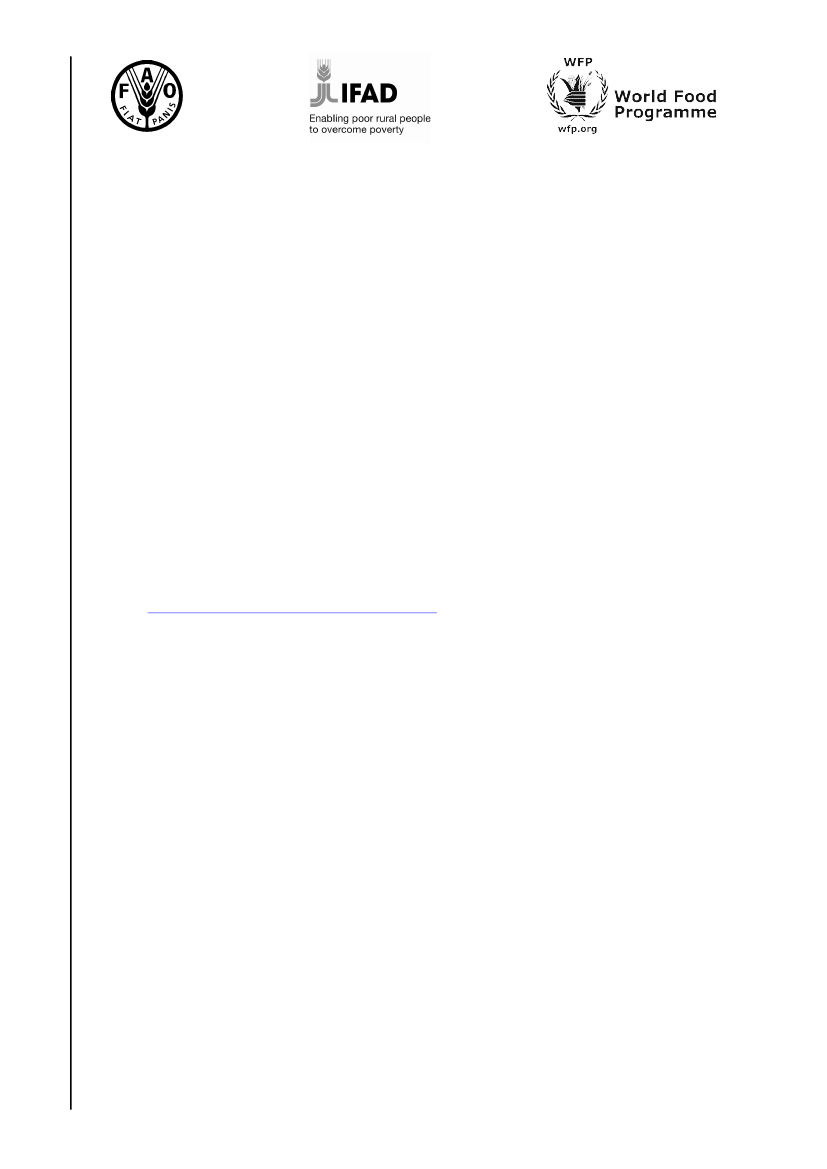Udenrigsudvalget 2012-13
URU Alm.del Bilag 19
Offentligt
Fighting Hunger Worldwide
Joint Release9 October 2012
GLOBALLY ALMOST 870 MILLION CHRONICALLYUNDERNOURISHED - NEW HUNGER REPORTBut there are hopeful signs that with extra effort the MDG target can be reached9 October 2012, Rome- Nearly 870 million people, or one in eight, were suffering fromchronic undernourishment in 2010 2012, according to the new UN hunger report released2010-2012,today.TheState of Food Insecurity in the World 2012(SOFI),jointly published by the UN Food and,Agriculture Organization (FAO), the International Fund for Agricultural Development(IFAD) and the World Food Programme (WFP), presents better estimates of chronicundernourishment based on an improved methodology and data for the last two decades.rnourishmentThe vast majority of the hungry, 852 million, live in developing countries -- around 15percent of their population -- while 16 million people are undernourished in developedevelopedcountries.The global number of hungry people declined by 132 million between 19901990-92 and 2010-12,or from 18.6 percent to 12.5 percent of the world's population, and from 23.2 percent to 14.9percent in developing countries - putting the MDG target within reach if adequate,thinappropriate actions are taken.The number of hungry declined more sharply between 1990 and 2007 than previouslybelieved. Since 2007-2008, however, global progress in reducing hunger has slowed and2008,leveled off."In today's world of unprecedented technical and economic opportunities, we find it entirelyunacceptable that more than 100 million children under five are underweight, and therefore
Via Cesare Giulio Viola, 68/70, 00148 Rome, Italy
Telephone: +39 06 65131
Fax: +39 06 6590632/7
page 2
unable to realize their full human and socio economic potential, and that childhoodsocio-economicmalnutrition is a cause of death for more than 2.5 million children every year," say JosétritionGraziano da Silva, Kanayo F. Nwanze and Ertharin Cousin, respectively the Heads of FAO,IFAD and WFP, in a foreword to the report."We note with particular concern that the recovery of the world economy from the recentglobal financial crisis remains fragile. We nonetheless appeal to the international communityto make extra efforts to assist the poorest in realizing their basic human right to adequatefood. The world has the knowledge and the means to eliminate all forms of food insecurityand malnutrition," they add.A "twin-track" approach is needed, based on support for broad based economic growthtrack"broad-based(including in agriculture) and safety nets for the most vulnerable.Impact of economic crisisThe new estimates suggest that the increase in hunger during 2007 2010 was less severe than2007-2010previously thought. The 20082008-2009 economic crisis did not cause an immediate sharpeconomic slowdown in many developing countries as was feared could happen; thewastransmission of international food prices to domestic markets was less pronounced than wasassumed at the time while many governments succeeded in cushioning the shocks andprotecting the most vulnerable from the effects of the pprice spike.The numbers of hunger released today are part of a revised series that go back to 1990. Ituses updated information on population, food supply, food losses, dietary energyrequirements and other factors. They also better estimate the distribution of food (asdistributionmeasured in terms of dietary energy supply) within countries.SOFI 2012 notes that the methodology does not capture the short term effects of food priceshort-termsurges and other economic shocks. FAO is also working to develop a wider set of indiindicators tobetter capture dietary quality and other dimensions of food security.MDG target within reachThe report suggests that if appropriate actions are taken to reverse the slowdown in 20072007-08and to feed the hungry, achieving the Millennium Development Goal (MDG) of reducing byDevelopmenthalf the share of hungry people in the developing world by 2015 is still within reach."If the average annual hunger reduction of the past 20 years continues through to 2015, the
page 3
percentage of undernourishment in the developing countries would reach 12.5 percent - stilldevelopingabove the MDG target of 11.6 percent, but much closer to it than previously estimated," thereport says.Asia leads in number of hungry; hunger rises in AfricaAmong the regions, undernourishment in the past two decades decreased nearly 30 percentin Asia and the Pacific, from 739 million to 563 million, largely due to sociosocio-economicprogress in many countries in the region. Despite population growth, the prevalence ofundernourishment in the region decreased from 23.7 percent to 13.9 percent.decreasedLatin America and the Caribbean also made progress, falling from 65 million hungry in1990-1992 to 49 million in 2010 2012, while the prevalence of undernourishment dipped19922010-2012,from 14.6 percent to 8.3 percent. But the rate of progress has slowed recently.theAfrica was the only region where the number of hungry grew over the period, from 175million to 239 million, with nearly 20 million added in the past four years. The prevalence ofhunger, although reduced over the entire period, has risen slightly over the past three years,from 22.6 percent to 22.9 percent - with nearly one in four hungry. And in subsub-SaharanAfrica, the modest progress achieved in recent years up to 2007 was reversed, with hungerrising 2 percent per year since then.erDeveloped regions also saw the number of hungry rise, from 13 million in 20042004-2006 to 16million in 2010-2012, reversing a steady decrease in previous years from 20 million in 19902012,1990-1992.Agricultural growth to reduce hunger and malnmalnutritionThe report underlines that overall growth is necessary but not sufficient for a sustainedhunger reduction. Agricultural growth is particularly effective in reducing hunger andmalnutrition in poor countries since most of the poor depend on agriculture and relatedagricultureactivities for at least part of their livelihoods. Agricultural growth involving smallholders,especially women, will be most effective in reducing extreme poverty and hunger when itgenerates employment for the poor.Growth must not only benefit the poor, but must also be "nutrition sensitive" in order to"nutrition-sensitive"reduce various forms of malnutrition. Reducing hunger is about more than just increasingthe quantity of food it is also about increasing the quality of food in terms of diversity,nutrient content and safety.utrient
page 4
For even while 870 million people remain hungry, the world is increasingly faced with adouble burden of malnutrition, with chronic undernourishment and micronutrientmalnutrition co-existing with obesity, overweight and related non-communicable diseasesexistingcommunicable(affecting more than 1.4 billion people worldwide).To date, the linkage between economic growth and better nutrition has been weak, the reportsays, arguing for an integrated agricultureagriculture-nutrition-health framework.healthSocial protection systemsGrowth is clearly important, but it is not always sufficient, or rapid enough. Hence, socialprotection systems are needed to ensure that the most vulnerable are not left behind and canalso participate in, contribute to and benefit ffrom growth.Measures such as cash transfers, food vouchers or health insurance are needed for the mostvulnerable who often cannot take immediate advantage of growth opportunities. Socialprotection can improve nutrition for young children - an investment that will pay off in thetfuture with better educated, stronger and healthier adults. With effective social protectioncomplementing inclusive economic growth, hunger and malnutrition can be eliminated.
ContactChristopher MatthewsFAO Media Relations (Rome)(+39) 06 570 53762[email protected]Jessica ThomasIFAD Media RelationsTel: 06-54592215[email protected]Emilia CasellaWFP, Global Media CoordinatornatorOffice: +39.06.6513.3854Mobile: +39.347.945.0634[email protected]




